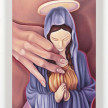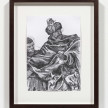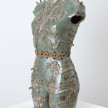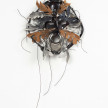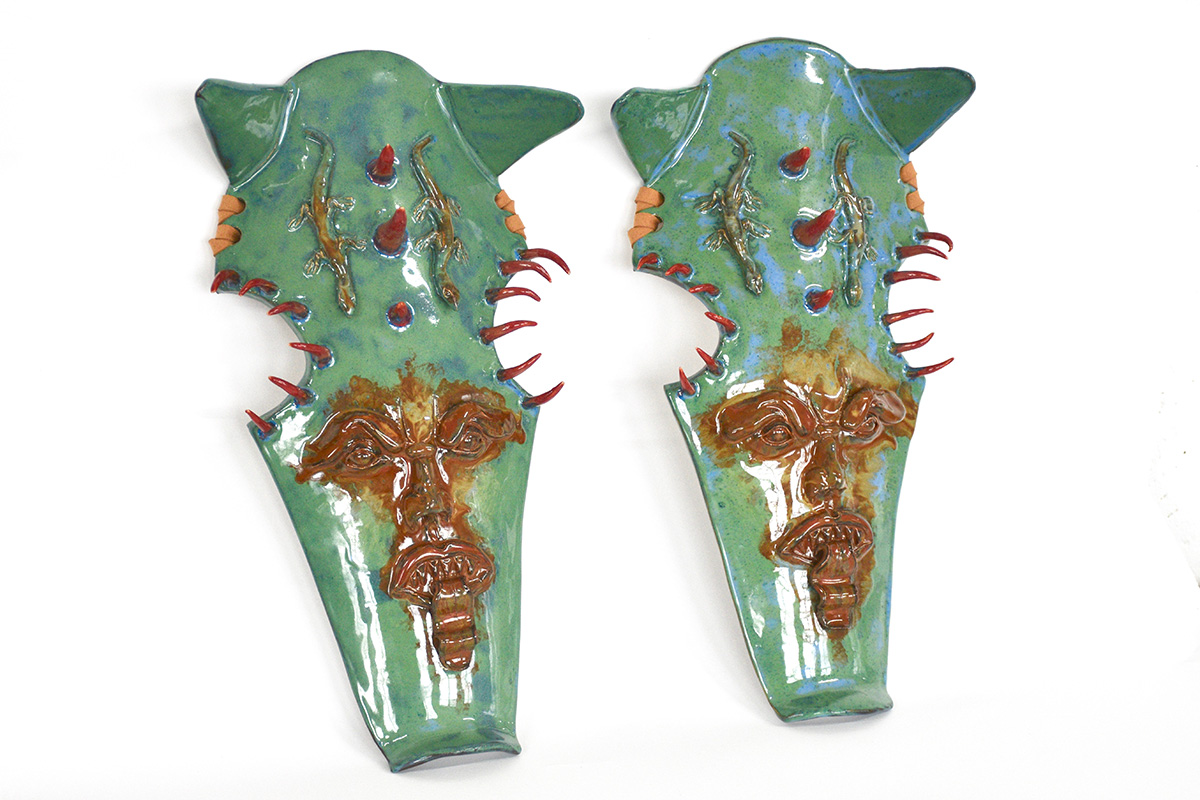July 8–August 5, 2023
Installation Views
Works
Steve Turner is delighted to present Illuminations, a group exhibition curated by Natalia Gonzalez Martin that features works by ten artists from Britain and Spain who make works inspired by Medieval or Renaissance art. The following text was written by Gonzalez Martin expressly for Illuminations.
Confronted with the beauty that perishes, security could be found in that interior beauty which does not perish.
Umberto Eco
Art and Beauty in the Middle Ages
On my last visit to the National Gallery, I noticed something new. It was a rainy Wednesday and I decided to take a day from my studio practice to gather inspiration. I entered the museum and headed towards the late medieval displays expecting a calm sanctuary away from the 1,500 daily visitors that roam the museum. To my dismay, I encountered herds of school kids looking up and pointing, tourists standing dangerously close to the works and more museum guards than those works had previously needed. What changed? People were looking for something and they were carefully scrutinizing the hyper-detailed scenes to find it. Ubi Sunt?
A protective feeling rose in me, similar to the one that arises when the obscure band you discovered and privately cherished suddenly is playing on every radio station. Where had these people been before? Go see the impressionists, I bitterly thought! I sat down and judged the crowd that obscured my previously unspoiled view. Saint Veronica held a cloth, but instead of Christ’s imprint, the holy shroud framed the back of a middle-aged man’s head.
Forgetting the original motive of my visit, I roamed around, angrily observing how my uncommon interest in this neglected period of history was being diluted with each visitor that entered the room. While caught up in my self-indulgent thoughts, a woman carrying a pram sat next to me. She freed her infant from his seat and placed him on her lap. He rested his sticky fingers on my coat. With a sympathetic instinct, I tried to make eye contact with his mother, but her eyes, unaware with tiredness, faced forward at a painting. Another mother of similar age was holding a child who had more energy than she could handle. The two women stared at each other with tender understanding. I instantly understood that this place of retreat was universal.
I left the gallery, and perhaps it was the frenzy London provides when the sun suddenly comes out, or the moving scene I had just witnessed, but all the anger dissipated into joy. I welcomed what I concluded was a change of collective sensibility. Everywhere I looked confirmed this. A bus publicized a new television program which featured dragons. The newsagent’s window was plastered with the image of a musician who was announcing her pregnancy with a picture that made her look like a Madonna. A young man walked by wearing a chainmail shirt. On social media, I noticed confessional texts that reminded me of St Augustine. The Middle Ages had returned!
When I got home I decided to do some research to see if anyone else had noticed this societal shift. I observed that people were comparing the current waves of migration to the Völkerwanderung phenomenon that took place between the 5th and 8th centuries. Others suggested that our current economic system was a return to feudalism. The Encyclopedia Britannica describes the Middle Ages as a confusing and contradictory period, when society was attempting to structure itself politically on a spiritual basis. That sounds like the present to me.
Perhaps we are done with over-rationalising life, and we are seeking something purer, or like Umberto Eco suggested, we are ready to leave abstract and rational concepts in favor of everyday feelings based on lived experience. Like many artists, I have been absorbed in this wondrous though perverse delight. My work often draws from the sensibilities of the past as I conflate them with our own. For Illuminations, I assembled a group of artists that likewise have been looking backwards to make sense of what’s in front of us.
Jesse Pollock is presenting three silver skulls made of discarded car parts, a memento mori of the consumer age. Jakob Rowlinson is showing masks made from found materials. Their leather faces are hollow, yet they are filled with desire, passion and guilt, a constant fight between carnival and lent. Ariane Hughes’ painting represents a struggle with society, an irreconcilable struggle between who we are and who we need to be. It makes me think of Catherine of Siena, of Heloise and of myself, unable to unite the different aspects of womanhood in one body. Marina Iglesias presents a highly defined world in immense detail, like that of Frangelico’s, where the waves move and the grass dances. Becky Tucker carves untold stories into her ceramic armor, protective devices of great vulnerability. If we look down at the earth, the land that feeds us, we can find Tuesday Riddell’s characters, the smallest beings alive, the ones we forget about. Snakes, flowers, and insects are framed by a golden light that could be taken out of Manipulus Florum. From all that movement and bustle, we are directed in the opposite direction, towards the quietness of Nina Silverberg’s paintings. Created with monastic meditation, she depicts objects whose impact surpasses the terrestrial. Similarly, through dogged research, Rosa-Johan Uddoh meticulously isolates African characters found in medieval paintings. Figures that are normally ignored become the main characters in her work. Los Bravu work collectively, their name is one and in unity they thrive. Like Boethius, Averroes or Abelard, they translate classical stories through contemporary symbols.
Ubi sunt? Here.
Ariane Hughes creates intricate, sleek, stylized, sensual and absurd paintings that draw from imagery common on social media platforms. She highlights incongruous associations to comment on the interplay between the real and unreal.
Hughes (Born 1995, Ibandan, Nigeria) earned a BA in Painting from Camberwell University (2019). She had a solo exhibition at Gnyp, Berlin (2022) and will open a solo exhibition at Steve Turner, Los Angeles concurrently with the opening of Illuminations. She lives and works in London.
Marina Iglesias creates paintings that are inspired by folklore, medieval and Renaissance painting, myth, tarot and ancient scientific illustration. She mixes together familiar and invented imagery within verdant landscapes that are rich with animals, flowers and trees. Reality and fantasy are indistinguishable in Iglesias’ evocative paintings.
Iglesias (born 1991, Puerto Real, Cádiz, Spain) earned a BA in Fine Arts and an MA in Artistic Production at the Universitat Politècnica de València. She has had solo exhibitions at Steve Tuner, Los Angeles (2023) and Tuesday to Friday Gallery, Valencia (2021). She also presented work in group exhibitions at Eligere Gallery, Seoul and at Kiaf, Seoul (2022).
Los Bravu has developed a multidisciplinary practice consisting of painting, performance, sculpture and comics through which they investigate contemporary issues. Their works are influenced by classical art from Greece and Rome as well as the Renaissance.
Dea Gomez (Salamanca, 1989) and Diego Omil (Pontevedra, 1988) met when they were studying Fine Arts at the University of Salamanca and began working together in 2012. Recent solo exhibitions have been presented at Yusto / Giner, Madrid (2022) and Galeria Trinta, Santiago de Compostela (2022).
Jesse Pollock creates sculptures for floor and wall using steel and silicone. Manipulating steel to realize benches, ladders and pots, Pollock utilizes images from the area of his birth, the rural region of Teynham in Kent. His work addresses the perpetual cycle of contemplation, procrastination, frustration and action that constitutes artistic process. He uses a variety of technologies including 3D modeling and iPhone drawings, however physical labor is his essential process.
Pollock graduated with a BA in Contemporary Art Practice from Camberwell College of Arts in 2015. He has had solo exhibitions at Steve Turner (Los Angeles (2020); VO Curations, Paris (2019) and Material Art Fair with Hannah Barry Gallery, Mexico City (2019). He lives and works in Kent.
Tuesday Riddell creates jewel-like lacquerware works that are inspired by nature and the forest floor. She carefully crafts nocturnal scenes that have rich blacks and contrasting gold leaf and has developed rare expertise in gilding, japanning, chinoiserie and marbling, all of which are kept alive as part of her studio practice.
Riddell graduated with a BA in Fine Art Painting from City & Guilds of London Art School and subsequently undertook a Fellowship at the same institution which focused on historic surface techniques. She had a solo exhibition with Messums Gallery, Wiltshire (2019) and will open her next solo exhibition with Messums in July 2023.
Jakob Rowlinson intertwines the natural world with medieval symbolism, questioning the bounds of masculinity throughout time. Using collage and assemblage, Rowlinson uses decorative patterns from medieval design and manuscripts with organic lines from moss, vines and ferns filling out his backgrounds.
Born in 1990, Rowlinson studied Fine Art at Ruskin School of Art, before completing an MA in Sculpture at the Royal College of Art, London. He has exhibited at Quench Gallery, Margate, Tandsticksmuseet, Jönköping, Sweden and Clearview, London. He was the 2022 Artist-in-Residence at Fores Project, London. He lives and works in London.
Nina Silverberg creates small-scale paintings in a muted palette that straddle abstraction and representation. Her most recent works depict solitary bed frames, medieval houses and gloves, timeless signifiers of human comfort. In one, falling drops of rain cover the entire work to suspend it in time.
Silverberg (b.1994 Rome, Italy) has presented work at Lee Eugean Gallery, Seoul (2022); Eve Leibe Gallery, London (2022) and Creekside, London (2020).
Becky Tucker ceramic sculptures could be best described as anachronistic artifacts, historically ambiguous due to the diverse source material they draw from. The mutable nature of symbols plays a strong role as she is interested in images that have been used to signify different things in different cultures. This enhances each object’s timelessness and allows for open-ended interpretations.
Tucker graduated from Edinburgh College of Art (2017) and was awarded a VACMA bursary (2022). Her work has been exhibited at The Tub Hackney, London; Saltspace Gallery, Glasgow and Bomb Factory, London. She lives and works in Glasgow.
Rosa-Johan Uddoh is an interdisciplinary artist who is inspired by Black feminist practice and writing. Through performance, video, writing and installation, she explores aspects of British popular culture as it relates to race.. Collaboration is often an aspect of Uddoh’s work. In past projects, she has worked together with children, activists and other artists to explore themes that impact community and to share knowledge.
Uddoh (b. 1993, Croydon) has had recent solo presentations at The Bower, London (2022); Iniva, London (2022); Focal Point Gallery, Southend-on-Sea (2021) and Destiny’s, Oslo (2020). She has also screened video work at Tate Modern, London (2019 and 2021) and was shortlisted for the Jarman Award (2022) for her filmmaking practice. Uddoh is a lecturer in Performance at Central Saint Martins.
Natalia Gonzalez Martin utilizes the formal qualities of icon painting to conflate the current moment with the past. She typically depicts women who have an ageless quality, who are demure, yet seductive and appealing, a cross between a 1940s pinup model and an Eve from a Lucas Cranach painting. As Martin paints with luscious oils on wood panels, she depicts skin tones of creamy white with accents of pink and red with just the right satin finish. Her figures are elegant, smooth, refined and ambiguous.
Gonzalez Martin (born 1995, Montejo de la Sierra, Spain) earned a BA in Painting at City & Guilds of London Art School (2017). Her work has been featured in solo and two-person exhibitions at Palazzo Monti, Brescia (2023); Galerie Sebastien Bertrand, Milan (2023); Steve Turner, Los Angeles (2022); Hannah Barry Gallery, London (2022); Galerie Sebastien Bertrand, Geneva (2021) and Quench Gallery, Margate (2021). Illuminations is Gonzalez-Martin’s most extensive curatorial initiative to date.



























